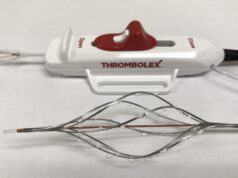
The “Standard versus ultrasound-assisted catheter thrombolysis for submassive pulmonary embolism” (SUNSET sPE) trial, a randomised, single-blinded clinical trial comparing ultrasound-assisted thrombolysis (USAT) to standard catheter-directed thrombolysis (SCDT), has completed enrolment, as announced on Friday 17 January by principal investigators Efthymios Avgerinos and Rabih Chaer (University of Pittsburgh Medical Center, Pittsburgh, USA).
The SUNSET sPE trial was designed to address the controversy of the role of ultrasound in improving clot reduction during catheter-directed thrombolysis for acute submassive pulmonary embolism. The study was launched as an institutional trial at the University of Pittsburgh Medical Center in 2016, and more recently two more institutions joined as collaborators; the Department of Cardiology, Emory University, and the Piedmont Heart Institute, both in Atlanta.
As reported in Venous News, participants were randomised 1:1 to a USAT catheter (EKOS System) or a SCDT catheter (Unifuse, Cragg-McNamara). Technical details of the procedure were left to the discretion of the treating physician, with a general guidance for short periods (less than 12 hours) of thrombolysis to match the favourable outcomes demonstrated by the “Optimum duration of acoustic pulse thrombolysis procedure in acute pulmonary embolism” (OPTALYSE) study.
In order to simulate real-life practice, termination was recommended when there was an objective improvement of vital or echocardiographic signs (pragmatic trial). The primary outcome was clearance of pulmonary thrombus burden, assessed by post-procedure computed tomography angiography using a modified Miller score.
According to the investigators, this was partly chosen due to thrombus clearance being the distinct assumed advantage of ultrasound-assisted catheter-directed thrombolysis, but most importantly because it is the only outcome that could power this randomised clinical trial, since the use of clinical outcomes would require a prohibitive sample size.
The study was powered for 80 patients to detect a 50% improvement in pulmonary artery thrombus clearance. Secondary outcomes include resolution of right ventricular strain by echocardiography; improvement in pulmonary artery pressures; and a three- and 12-month improvement in echocardiographic, functional capacity, and quality of life measures.
Efthymios Avgerinos (University of Pittsburgh Medical Center, Pittsburgh, USA) presented interim results of the overall outcomes at the Society for Vascular Surgery (SVS) Vascular Annual Meeting (VAM; 12–15 June, National Harbor, USA).
It was shown that catheter thrombolytic techniques can achieve a significant and quick thrombus and RV/LV ratio reduction, and are safe and effective. With enrolment complete, follow-up data and analyses are pending, and comparative results will be announced within the forthcoming months.












